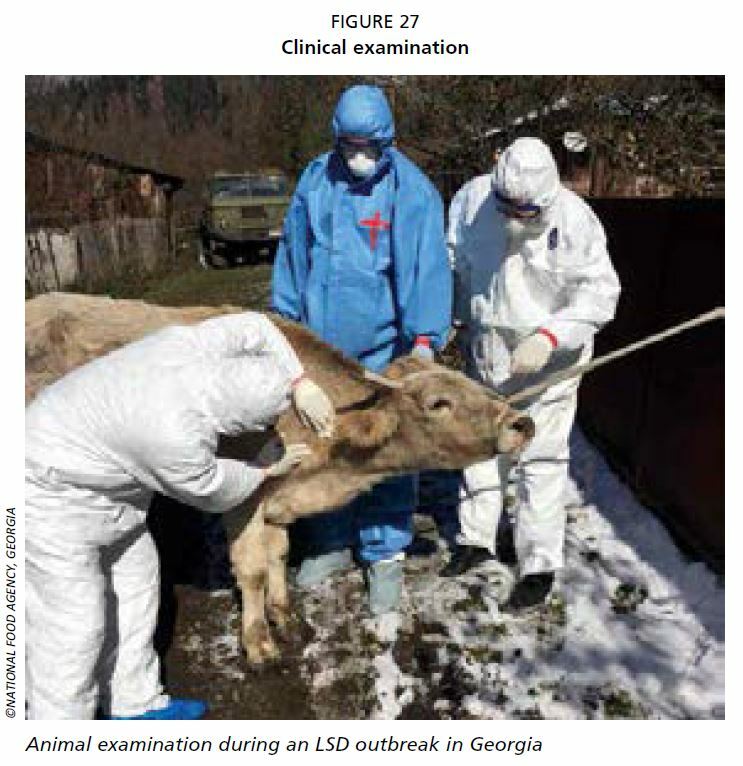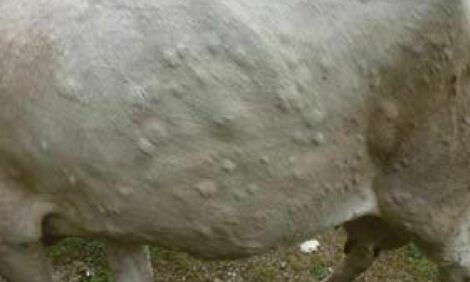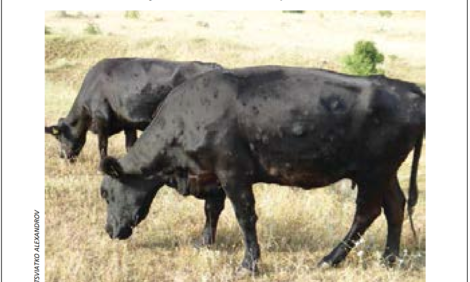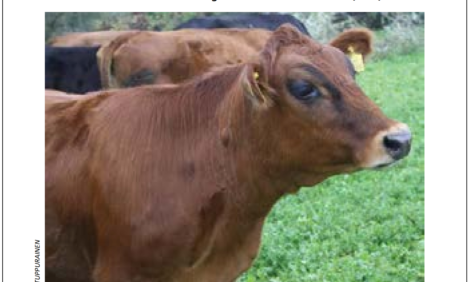



Lumpy Skin Disease: Measures on the farm in case of suspicion
Learn more about lumpy skin disease (LSD)Editors note: The following content is an excerpt from Lumpy Skin Disease: a field manual for veterinarians which is designed to enhance awareness of lumpy skin disease and to provide guidance on early detection and diagnosis for private and official veterinary professionals (in the field and in slaughterhouses), veterinary paraprofessionals and laboratory diagnosticians.
If a suspected case of LSD is detected by an owner, private veterinarian, animal trader, cattle truck driver, artificial inseminator, or any other visitor, a competent veterinary authority should be informed without delay and an official veterinarian/veterinary team should visit the farm to carry out an outbreak investigation. Ideally, an investigation kit should be kept in each local veterinary office so that the attending veterinarian can set off to investigate with minimum delay. The equipment should include a digital camera, a GPS unit and a means of rapid communication (often a mobile phone, but could be a radio), as well as consumables and materials to collect and transport samples (FAO, Good Emergency Management Practice [GEMP], 2011). Measures at an affected farm holding should include:
- If possible, separate the suspected case(s) from the rest of the herd.
- Collect blood in EDTA tubes and whole blood for serum samples, saliva/nasal swabs and skin lesions or scabs for laboratory testing. In the case of several animals showing clinical signs, samples from approximately five animals should be sufficient for diagnosis.
- Organize transport of the samples to a national reference laboratory without delay.
- Inform the competent authority and the reference laboratory that you are going to send samples containing potentially infectious LSD virus: indicate the number of samples you are sending.
- If possible, separate the rest of the animals from neighbouring herd(s) by feeding them on the farm and avoiding communal grazing.
- Neighbouring farmers, and those who have bought or sold animals from/to the affected farm recently, should be notified and placed under intensified surveillance. Cattle with or without clinical signs should be sampled.
- Stop cattle movement from/to the farm and limit visitors to essential services.
- Carry out clinical examinations on the rest of the animals (in each farm subunit) and systematically record the findings, including rectal temperature, in order to determine if any of the animals may already be incubating the disease. A prepared form may help you to record the findings efficiently. If a large number of animals are present, you may need to prioritize which animals you examine.
- Disinfect your hands, footwear, and outfit using any common disinfectant and when at home/office wash the clothes at +60 °C.
- Disinfect equipment and materials used in the affected holding, as well as the wheels of your vehicle on exit.
- The application of spot-on repellents on the animals at the affected and neighbouring farms is highly recommended as a supportive measure to protect cattle from insects.
- If possible, transfer the rest of the day’s veterinary farm visits to a colleague.
How to conduct an outbreak investigation
Collecting, recording, and analysing epidemiological data on LSD outbreaks is crucial in order to implement an effective and feasible strategy to control and monitor the impact of activities.
Carrying out an epidemiological interview requires specific skills in circumstances
where farmers are likely to be under considerable stress. In an intensive cattle farming unit, the farm manager and workers often have more day-to-day contact with animals than the farm owner. An outbreak investigation should prioritize the following:
a) how long the disease has been present;
b) magnitude of the problem: number of cases, definition of epidemiological units and population at risk;
c) possible sources of infection;
d) movements of animals, people, vehicles, or other fomites that may have spread the disease.
It is often helpful to sketch out a map of the area, showing the location of animal housing, animal groups, entry and exit points, and boundaries.
The following data should also be included in an outbreak investigation:
- number of animals in the herd, number of suspected animals, estimated age of lesion(s);
- origin, age, sex, breed, production type and vaccination status of suspected animals;
- contacts with other herds and use of communal grazing; contacts with wild ruminants;
- cattle movement records – new animals recently introduced into a herd and their origin; animals that have left the herd and their destination;
- movements of animal care staff and other visitors;
- recent veterinary treatments and cattle health records;
- artificial inseminator visits and use of a breeding bull;
- milk collection vehicle;
- animal trader/slaughterhouse transport vehicle visits: any farms visited before and after;
- potential vector activity, presence of vector breeding sites such as lakes, rivers;
- road network, other geographic and climatic data;
- a survey of the premises should be made and potential vector breeding sites removed.
Reference:
Tuppurainen, E., Alexandrov, T. & Beltrán-Alcrudo, D. 2017. Lumpy skin disease field manual – A manual for veterinarians. FAO Animal Production and Health Manual No. 20. Rome. Food and Agriculture Organization of the United Nations (FAO). 60 pages.






